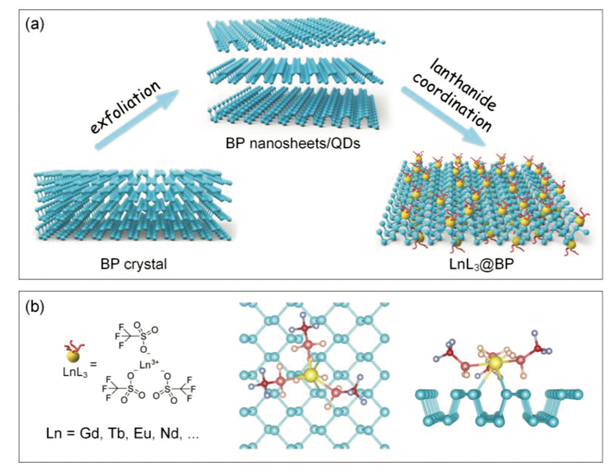Among various types of 2D materials, black phosphorus (BP) is a shining star thanks to its distinctive properties such as the layer-dependent band gap, active surface electronic states, good biocompatibility and excellent photothermal properties. However, due to the lone-pair electrons, BP is not stable in oxygen-water ambient condition. Besides, phosphorus is present in cells, tissues and bones, which makes it difficult to trace the BP-based nanostructures by conventional imaging techniques and conduct detailed biomedical studies in vivo.

(a) Schematic diagram illustrates the synthesis of lanthanide-coordinated BP nanosheets/QDs. (b) the formula of LnL3 and the atomistic model of the lanthanide ligand coordinated BP surface.
To address this challenge, a team led by YU Xuefeng at the Shenzhen Institutes of Advanced Technology (SIAT) of the Chinese Academy of Sciences has developed a series of methods to modulate the surface properties and to improve the stability performance of BP, such as organic coating, chemical coordination, covalent modification, ions doping and defects occupation.
Recently, YU and his co-workers developed a facile and efficient surface lanthanide-coordination strategy based on lanthanide (Ln) sulfonate complexes to passivate and functionalize different BP-based nanostructures. By means of Ln-P coordination, the lone-pair electrons of phosphorus were occupied, preventing the oxidation of BP, and the LnL3@BP exhibited excellent stability in both air and water. And after LnL3 coordination, the original photothermal ability of BP nanostructures was retained.

Lanthanide-coordination to protect the black phosphorus from damage of oxygen (Image: YU Xuefeng).
“The LnL3 surface passivation is an efficient method to enhance the stability of BP and can extend the application of BP to optoelectronics and biomedical engineering as well,” said YU. “We hope that the lanthanide-coordinated BP could be tracked in vivo to investigate the metabolic pathway of nano BP.”

